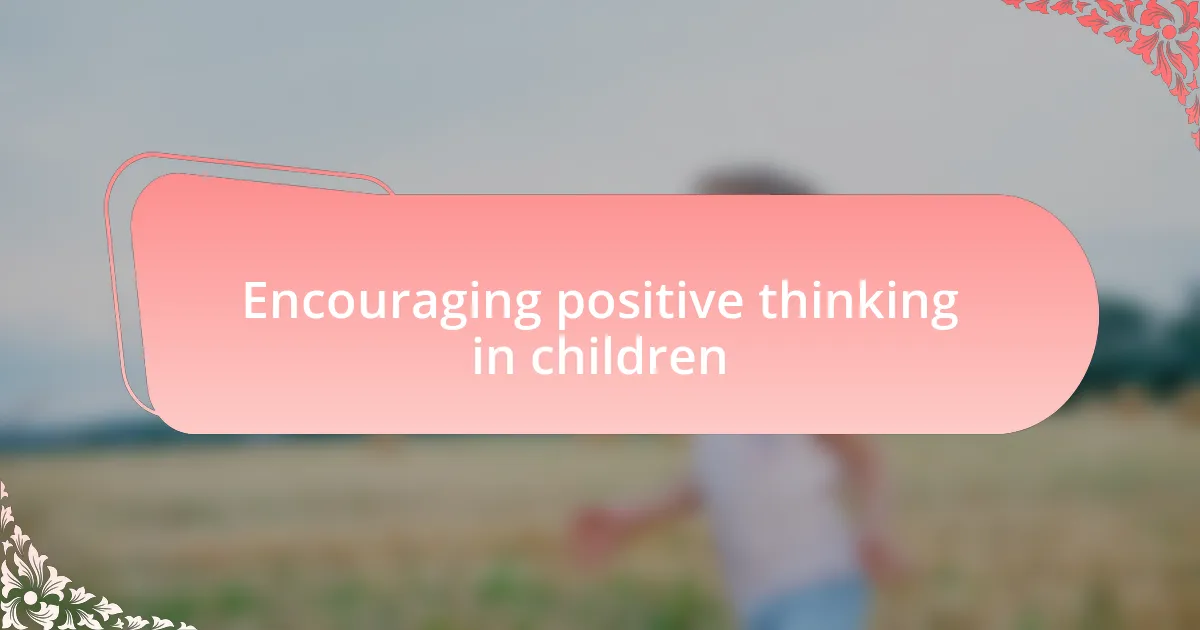Key takeaways:
- Negative thoughts are reflections of emotions, not facts; recognizing this can help regain control and foster a healthier mindset.
- Techniques such as grounding, challenging negative thoughts, and journaling can effectively manage overwhelming feelings.
- Modeling optimism and practicing gratitude and affirmations can encourage positive thinking in children.
- Seeking professional help can provide valuable strategies for children struggling with persistent negative thoughts.

Understanding negative thoughts
Negative thoughts are often those little whispers in our minds that can create a significant impact on our emotional well-being. I remember a time when I would sit up late, feeling overwhelmed by worries about my child’s future. It’s almost as if those thoughts were magnifying everything that wasn’t perfect in our lives, leaving me feeling anxious and powerless.
What I have learned over the years is that negative thoughts are not facts; they are just reflections of emotions influenced by our experiences and surroundings. Have you ever noticed how one negative thought can spiral into a cascade of worries? It’s like setting off a chain reaction, transforming a single doubt into a plethora of insecurities.
Recognizing negative thoughts as temporary feelings rather than enduring truths has been a game-changer for me. I often remind myself that it’s okay to feel overwhelmed, but it’s essential to confront those thoughts head-on. Understanding this distinction helps me regain control and fosters a healthier mindset, especially when it comes to supporting my child’s health and happiness.

Techniques for managing negative thoughts
When I find myself trapped in a swirl of negativity, one technique I rely on is grounding myself in the present moment. For instance, during a particularly stressful day, I might take a few deep breaths and focus on my surroundings. This simple practice helps me to detach from my racing thoughts, allowing clarity to seep in. Have you ever paused to notice the sounds or smells around you? It’s remarkable how tuning into your environment can dilute the power of negative thinking.
Another effective method I’ve used is to challenge those negative thoughts by asking myself, “Is this thought helpful?” I vividly recall a time when I panicked about my child’s health during flu season, convinced that the worst would occur. By consciously questioning my fears, I was able to reframe my narrative, reminding myself that I was doing everything I could to keep my child safe. This small shift in perspective made a world of difference; it was liberating to take a step back and assess my worries.
Lastly, I’ve found that journaling provides a powerful outlet for processing emotions. Whenever I feel overwhelmed, I put pen to paper, writing down my thoughts and feelings. It’s as if the ink absorbs the negativity, turning it into something tangible I can understand better. Have you tried this? It often helps me see patterns in my thinking and identify triggers, allowing me to tackle my negative thoughts with more resilience.

Encouraging positive thinking in children
One of the most meaningful ways to encourage positive thinking in children is to model optimism myself. I remember a time when my child was upset over a lost toy. Instead of diving into despair with them, I gently reminded them how great it is to think about the fun times they had with that toy and how we could find something new to play with together. This simple shift transformed their tears into a smile, showcasing how my attitude influenced their perspective.
In conversations with my child, I often emphasize gratitude. Each night, we share three things we appreciated that day. It’s been astonishing to witness how this practice has reshaped my child’s outlook. They now approach challenges with a sense of curiosity rather than fear. Have you ever noticed how focusing on the good can shift the entire day’s energy? It’s a powerful reminder that joy can be reclaimed even in tough moments.
Affirmations have also played a role in promoting positivity. I’ve seen firsthand how repeating phrases like “I am brave” or “I can try again” can resonate deeply with my child. On days when they struggle with homework, I gently guide them to voice these affirmations. This practice not only helps them find strength but also fosters resilience. How amazing is it to witness a child learning to combat negativity with words of encouragement? It’s truly heartwarming to see them develop this invaluable skill that will serve them well throughout life.

Sharing experiences and coping strategies
Sharing experiences can be incredibly beneficial, both for children and parents. Once, during a school project, my child felt overwhelmed by the sheer volume of work. I shared my own experience of tackling a daunting task by breaking it down into smaller steps. Watching them take a deep breath and approach it bit by bit reminded me of the power of shared stories. Have you ever noticed how relatable experiences can serve as a lifeline for emotional support?
Coping strategies can be incredibly effective when tailored to one’s feelings and circumstances. We’ve found that journaling helps my child process their thoughts during tough times. After a particularly challenging day, they felt lighter simply by writing it down. I often reflect on how therapeutic this has been for both of us. Does writing also provide you or your child a sense of relief?
Engaging in creative activities offers a delightful escape from negative thoughts. I recall a weekend when we spent hours painting together, each stroke releasing a bit of our frustrations. For my child, it turned into a moment of joy, where creativity took center stage over negativity. How often do we forget the healing power of art in our lives? It’s these moments that remind me how nurturing creativity can open doors to emotional expression and release.

Seeking professional help when needed
Sometimes, the challenges our children face feel too big for us to handle alone. I remember a time when my child was grappling with persistent negative thoughts that seemed to cloud their mood daily. Despite trying various coping strategies, I could sense their struggle was deeper than what we could manage together, prompting me to seek the guidance of a professional. Have you ever wondered if a trained specialist could offer tools we might overlook as parents?
Reaching out for professional help can be a game changer. After connecting my child with a child psychologist, I witnessed a significant transformation. The therapist provided tailored strategies that resonated with my child, allowing them to express their feelings in ways I hadn’t thought possible. Doesn’t it reassure you to know that sometimes, a fresh perspective can unlock new pathways to healing?
In my experience, the key is not just recognizing when to seek help, but also understanding that it’s a brave step. I once hesitated, fearing judgment or misunderstanding, but I learned that prioritizing my child’s mental health was far more essential. How often do we overlook the importance of professional support in our mental wellness journey? It’s essential to remind ourselves that asking for help is a strength, not a weakness.